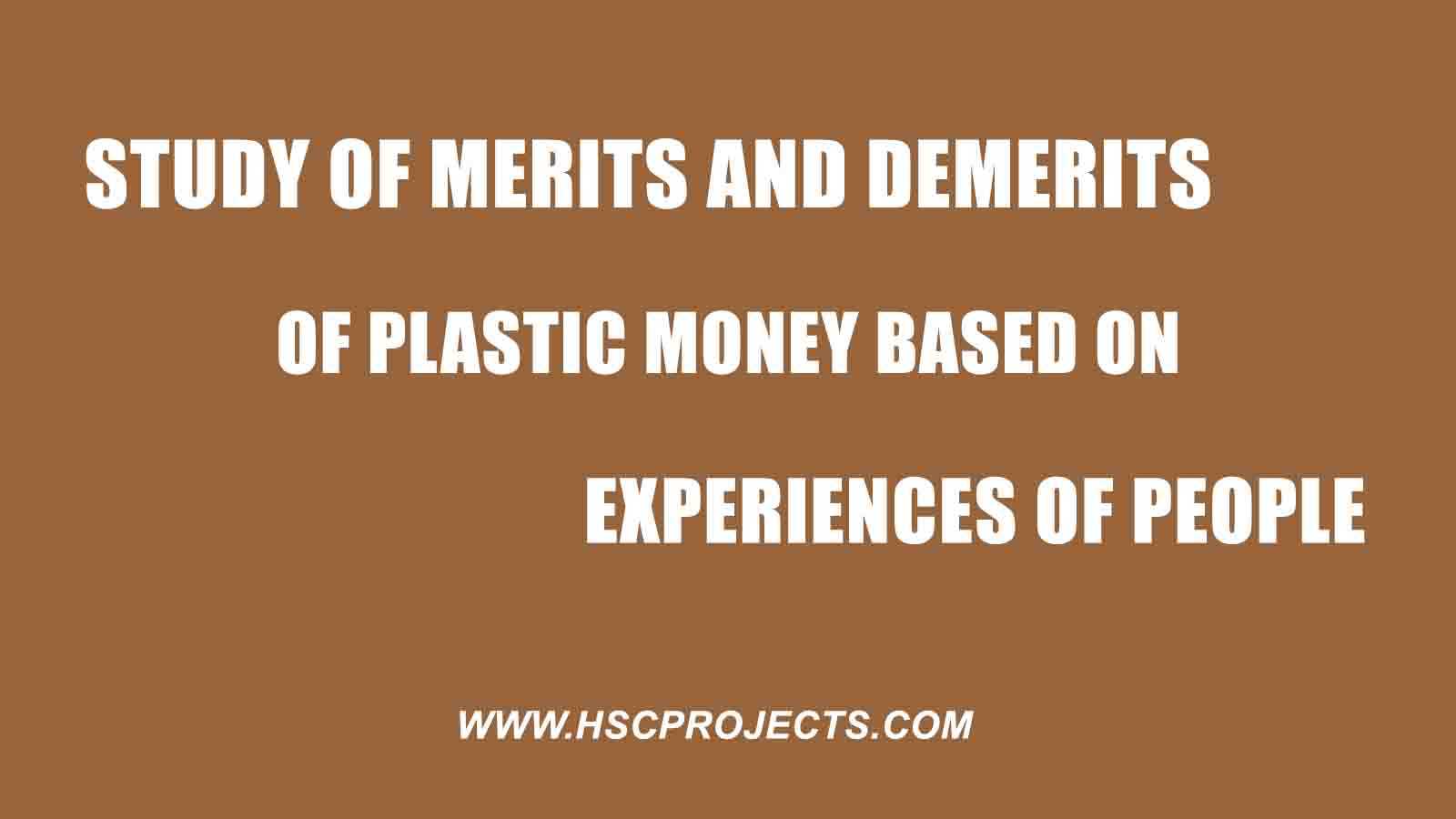
Study of Merits and Demerit of Plastic Money Based on Experiences of People
INTRODUCTION:
Introduction to Plastic Money
Plastic money or polymer money, made out of plastic, is a new and more natural way of paying for goods and services. Plastic money was introduced in the 1950s and is now an essential form of immediate payment, which reduces the risk of handlings a huge amount of cash. It includes Debit cards, ATMs, smart cards, etc. Credit cards, variants of plastic money, are used as substitutes for currency.
Meaning
Plastic money refers to credit cards; we use them whenever we want and pay later (with interest, of course). It makes it too easy for us to buy things we usually could not afford, which makes it easier to get into debt.
Definition
A slang phrase for credit cards, mainly when such cards used to make purchases. The “plastic” portion of this term refers to the plastic construction of credit cards, as opposed to paper and metal currency. The “money” portion is an erroneous reference to credit cards as a form of money, which they are not. Although credit cards do facilitate transactions, because they are a liability rather than an asset, they are not money and not part of the economy’s money supply.
History of Credit Cards and Debit Cards In Plastic Money
Credit cards have evolved into a safe and secure manner to purchase goods and services. The internet has given credit card users additional purchasing power. Banks have options like cash-back rewards, saving plans, and other incentives to entice people to use their cards. Debit cards allow people the convenience of cards without the worry of racking up debt. The comfort, security, and rewards offered by credit and debit cards keep shoppers using their cards as opposed to cheques or cash.
Credit Card Origins
Individual stores and merchants issued the first credit cards. These cards were issued in limited locations and only accepted by the business that issued them. While the cards were convenient for the customers, they also provided customer loyalty and customer service benefit, which was suitable for both customers and merchants. It was not until 1950 that the Dinner’s Club card was created by a restaurant patron who forgot his wallet and realized there needed to be an alternative to cash only. This started the first credit card specifically for widespread use, even though it was primarily used for entertainment and travel expenses.
Plastic Becomes the Standard
The first Diner’s Club cards were made out of cardboard or celluloid. In 1959 American Express changed all that with the first card made of plastic. American Express created a system of making an impression of the ticket presented at the register for payment. Then that impression was billed to the customer and due in full each month. Several American Express cards till operating like this as of 2010. It was not until the late 1980s that American Express began allowing people to pay their balance over time with additional card options.
Bank Card Associations
In 1966, Bank of America created a card that was a general-purpose card or “open-loop” card. These “closed-loop” agreements limited cards like Diners Club and American Express to individual merchants, unlike the new “open-loop” cards. The new general-purpose system required interbank cooperation and additional regulations. To his created other safety features and began building the credit card system of today. Two systems emerged as the leaders–Visa and Master Card. However, today, there is little difference between the two, and most merchants accept both card associations.
Debit Cards Emerge
The Visa association of cards took credit cards to a new level in 1989when they introduced debit cards. These cards linked consumers to their checking accounts. Money was now drawn from a checking account at the point of sale with these new cards and replaced check writing. This helped the merchants check that money was available and made it easier to track the customer if the funds could not be obtained. Consumers liked the convenience of not having to write checks at the point of sale, which made debit cards a safe alternative to cash and checks.
The Future
There were almost 29 million debit card users as of 2006, with a projected 34.4 million users by 2016. However, online services like PayPal are emerging as a way for people to pay their debts in new, secure, and convenient forms. Technology also exists to have devices implanted into phones, keys, and other everyday devices so that the ability to pay at the point of sale is even more convenient.
AIMS AND OBJECTIVES :
To study the merits and demerits of plastic money based on experiences of people
Objectives of the project are as follows
- To consider the benefits of plastic money
- To examine the faults of plastic money
- To study how plastic money is changing today’s world
- To explore how scammers take advantage of ordinary peoples
- To consider how time-saving plastic money can be
To study how to use plastic money worldwide
METHOD AND METHODOLOGY :
Research Methodology refers to the search of knowledge .one can also define research methodology as a scientific and systematic search for required information on a specific topic. The word research methodology comes from the word “advanced learner’s dictionary meaning of research as a careful investigation or inquiry primarily through analysis for new facts in my branch of knowledge; for example, some author has to define research methodology as a systematized effort to gain further understanding
Primary data collection:
In dealing with the real-life problem, it is often found that data at hand are inadequate, and hence, it becomes necessary to collect data that is appropriate. There are several ways of managing the relevant data which differ considerably in the context of money costs, time and other resources at the disposal of the researcher
Through personal interviews:-
A rigid procedure was followed, and we were seeking answers to many pre-conceived questions through personal interviews.
Through questionnaire:-
Information to find out the investment potential and goal was found out through surveys.
Through Tele-Calling:-
Information was also taken through telephone calls.
Secondary sources of data:
The secondary sources of data are used. (Internet, magazine, books, journals)
DETAIL REPORT OF PROJECT :
A credit card is a small plastic card issued to users as a system of payment. It allows its holder to buy goods and services based on the holder’s promise to pay for these goods and services. The issuer of the card grants a line of credit to the consumer or the user) from which the user can borrow money for payment to a merchant or as a cash advance to the user. Usage of the term “credit card” to imply a credit card account is a metonym. When a purchase is made, the user would indicate consent to pay by signing a receipt with a record of the card details and indicating the amount to be paid. The issuer agrees to pay the merchant, and the credit card user agrees to pay the card issuer.
Definition:-
The credit card can be defined as “A small plastic card that allows its holder to buy goods and services on credit and to pay at fixed intervals through the card-issuing agency.
Meaning:-
A credit card is a card or mechanism which enables the cardholder to purchase goods, travels, and dine in a hotel without making immediate payments. The holders can use the cards to get credit from banks up to 45days. The credit card relieves the consumers from the botheration of carrying cash and ensures safety. It is a convenience of extended credit without formality. This credit card is a passport to “safety, accessibility, prestige, and confidence.

Advantages of Plastic Money
The benefits of a credit card can be grouped as follows:
Advantages or Benefits of plastic money to Bank:
- A credit card is an integral part of banks’ primary services these days. The credit card provides the following advantages to the bank. The system offers an opportunity for the bank to attract new potential customers.
- To get new customers, the central bank has to employee special trained staff. This allows the bank to find the latent talent from among existing staff that would have been otherwise wasted.
- The essential function of a credit card, however, is to yield a direct profit for the bank. There is a scope, and a potential for better profitability out of income/ commission earned from the trader’s turn over.
- This also provides additional customer services to existing clients. It enhances customer satisfaction.
- More use by the cardholder and, consequently, the growth of banking habits in general.
- The better network of cardholders and increased use of cards means higher popularity and image of the bank
- Savings of expense on cash holdings, i.e., stationery, printing, and workforce to handle clearing transactions while considerably is reduced.
Also, check out this project on Cashless Economy CBSE Board. It will provide you all the valuable data related to cashless economies like credit cards, debit cards, bank transfer, etc
Advantages or Benefits of plastic money to Card Holder:
The principal advantages of a cardholder are:
- He can purchase goods and services at a large number of outlets without cash or cheque. The card is useful in an emergency and can save embarrassment.
- The risk factor for carrying and storing cash is avoided. It is convenient for him to take a credit card, and he has trouble-free travel and may purchase without sending cash or cheque.
- Months purchases can be settled with a single remittance, thus, tending to reduce bank and handling charges.
- The cardholder has a period of free credit, usually between 30-50 days of purchase.
- Cash can usually be obtained with the card, either on card account or by using it as identification when encasings a cheque at the bank.
- I am availing credit with minimum formality.
- The credit card saves trouble and paperwork for the traveling businessman.
Advantages or Benefits of plastic money to the Merchant Establishment:
The principal benefits offer a credit card to the retailer is:
- This will carry prestigious weight to the outlets.
- Increases in a sale because of the increased purchasing power of the cardholder due to unbilled credit available to the holder.
- The retailers gain from impulse buying and trading up to the tendency to buy a bigger or better article.
- A credit card ensures timely and indeed of payments.
- Suppliers/ sellers no longer have to send reminders of outstanding debts.
- Systematic accounting since sales receipts is routed through banking channels.
- Advertising and promotional support on a national scale.
- Development of a prestigious clientele base.
Disadvantages of Plastic Money
The following are the common disadvantages of the credit card:
- Some credit card transactions take longer time than cash transactions because of various formalities.
- The customer tends to overspend out of immense happiness.
- Discounts and rebates can rarely be obtained.
- The cardholder is responsible for charges due to loss or theft of the card and the bank may not be a party for damage due to fraud or collusion of staff, etc
- Customers may be denied a cash discount for payment through the card.
- It might lead to spending habits, and cardholders may end up in significant debts
- Avoid the entire cost and security problem involved in handling cash.
- Losses to bad debts and reduced additional liquidity is
- It also allows him to delegate spending power to add on members
- A credit card is considered as a status symbol.
Issuer:
The financial institution or other organization that issued the credit card to the cardholder.
The flow of information and money between these parties — always through the card associations — is known as the interchange, and it consists of a few steps:
- Authorization:–
The cardholder pays for the purchase, and the merchant submits the transaction to the acquirer. The acquirer verifies with the issuer — almost instantly — that the card number and transaction amount are both valid, and then processes the transaction for the cardholder. - Batching:–After the transaction is authorized, it is then stored in a batch, which the merchant sends to the acquirer later to receive payment (usually at the end of the day).
- Clearing and settlement:-
The acquirer sends the transactions in the batch through the card association, which debits the issuers for payment and credits the acquirer. In effect, the issuers pay the acquirer for the transactions. - Funding:-
Once the acquirer has been paid, the merchant receives payment. The amount the merchant receives is equal to the transaction amount minus the discount rate, which is the fee the merchant pays the acquirer for processing the transaction. The entire process, from authorization to funding, usually takes about three days. However, Merchant Card Processing from some banks and financial institutions can offer next-day deposits to their customers with a business checking account. In the event of a chargeback (when there’s an error in processing the transaction or the cardholder disputes the sale), the issuer returns the sale to the acquirer for resolution. The acquirer then forwards the chargeback to the merchant, who must either accept the chargeback or contest it.
ANALYSIS OF DATA :

Following are the findings that are drawn from the study:
- Respondents taken for this study are those who are using plastic money in their daily life.
- 62% of the respondents believe that plastic money is the currency of modern India.
- 69% of respondents own one debit card, and 25% own two debit cards.
- People have less craze for a credit card. Only 28% of the respondents have a credit card.
- Respondents mostly prefer the plastic money of SBI Bank, HDFC Bank, and ICICI Bank.
- 34% using the cards for the last three years, and the trend of plastic money has emerged from the previous few years.
- Most people use the cards for shopping and withdrawal of money- plastic money is mostly preferred at the time of shopping.
- A debit card is more beneficial, according to 36% of respondents.
- A debit card provides security to the cardholders.
- 20% of respondents are dissatisfied that debit card is free from fraud.
- Most people agreed that a debit card provides the facility for anytime access. Anytime you can withdraw your money.
- A credit card is a convenient way to pay agreed by most of the respondents.
- A credit card provides prestige to holders having the tie-up with the famous card companies. It gives a sense of pride.
- 30% cardholder agreed that the plastic money holders have to tackle the problem of insecurity.
- Cardholders have to fulfill the unnecessary formalities while obtaining the card.
- Plastic money has a rapid growth in the coming years.
The growth credit card in India is still very slow. Companies are going hard to increase the sale of credit cards.
CONCLUSION:
In the last two years, spending pattern through plastic money has changed drastically. Travelling, dining, and jewelry are the top three purchases that Indian makes through credit cards. Two years ago, it was jewelry and apparel purchases that formed the most significant chunk of investments through plastic money. Fuel accounts for a tiny portion of credit card purchases, as these are primarily paid through debit cards.
Consumers were not only more open to the possibility of owning a business card but were also more than willing to use their cards to settle dues. The status symbol aspect of owning and using cards, too, played its part in bringing about such robust growth over the space of a single year. Debit cards, in particular, proved immensely popular.
According to projections for the 2003-2008 period, the number of financial cards in circulation will register a compounded annual growth rate of nearly 51 percent sp the satisfaction of consumers has also increased. There are many ethical issues and challenges for plastic money issuing banks/ companies. Security relating to the card should be the priority for each bank/company.
Consumers prefer these cards mostly for shopping online E-commerce has given a better way to use plastic money.
At last, it is concluded that plastic money has a very bright future in the coming years because of the increasing trend of E-commerce.
DISCUSSION:
Some people prefer the simplicity of debit cards: you buy something, and your money goes away. My friend elaborates
“I have a debit card (with no fees or anything) and hope I never have to get a credit card. With a debit card, I pay exactly what the item is worth and no more since there is no interest. I don’t have to jump through any hoops for “miles” or “points” or any other nonsense. What it boils down to is that debit card is the simple choice for people that want to spend the money they have without actually carrying any around or any of the conditions associated with a credit card.”
ACKNOWLEDGMENT:
My profound gratitude to all the faculty members of the Department, for their timely assistance and encouragement throughout my research work.
I duly acknowledge the encouragement and support of the research scholars in the department, and all my colleagues and friends.
It gives me immense pleasure to take the opportunity to all the people who are directly or indirectly involved in the completion of my project based on Study of merits and demerit of plastic money based on experiences of people
With deep reverence, I offer my deepest gratitude _____, without whom this project could not have been fulfilled.
Lastly, I thank Almighty, my parents, family members, friends, and teachers for their constant encouragement and support, without which this project would not be possible.
Name of School/College
BIBLIOGRAPHY / REFERENCE :
- Kothari C.R, “Research Methodology: Research and Techniques,”; Vishwa Prakashan, New Delhi, 4th edition.
- E.gordan and Natrajan, Financial Services, Himalaya Publishing House, Mumbai. 5th edition.
- College Student using the Credit Card
- Smart card-based Electronics Commerce characteristics and Roles
- Credit card and Debit cards: What new? Where to?
- Competition and Credit and Debit card Interchange Fees
- Theory of Credit card Networks: A survey of Literature
- An introduction to the economics of payment card networks
- Credit card crisis in South Korea
- Ethical Issues and Challenges
- www.rba.gov.au
- www.federalreserve.gov
- www.direct.gov.uk
- www.paypal.com
- www.google.com
In order to download the PDF, You must follow on Youtube. Once done, Click on Submit
Follow On YoutubeSubscribed? Click on Confirm
Download Study of Merits and Demerit of Plastic Money Based on Experiences of People PDF







Thank u
Realt this link is very useful for clg students
Really such nice information about the this topic and very help full all students and special thanks to the invasion in information thanku
It is very useful to me for collect information about project